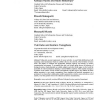Free Online Productivity Tools
i2Speak
i2Symbol
i2OCR
iTex2Img
iWeb2Print
iWeb2Shot
i2Type
iPdf2Split
iPdf2Merge
i2Bopomofo
i2Arabic
i2Style
i2Image
i2PDF
iLatex2Rtf
Sci2ools
IJSNET
2010
2010
Reaction-diffusion based autonomous control of wireless sensor networks
Abstract: Taking into account requirements of sensor networks, we need fully-distributed and selforganising control mechanisms which are scalable to the size of a network, robust to failures of sensor nodes, and adaptive to different and dynamically changing topology and changes in wireless communication environment. To accomplish this goal, our research group focuses on behaviour of biological systems, which inherently are scalable, adaptive and robust. In this paper, we first verify the practicality of control mechanisms adopting a reaction-diffusion equation, which explains emergence of patterns on the surface of body of fishes and mammals, and then propose two methods for faster pattern generation to save energy consumption. Prom simulation and practical experiments on a prototype, it was shown that a stable pattern could be generated in a wireless sensor network in several minutes, even when packets were lost for collisions in wireless communication.
| Added | 18 May 2011 |
| Updated | 18 May 2011 |
| Type | Journal |
| Year | 2010 |
| Where | IJSNET |
| Authors | Katsuya Hyodo, Naoki Wakamiya, Etsushi Nakaguchi, Masayuki Murata, Yuki Kubo, Kentaro Yanagihara |
Comments (0)

